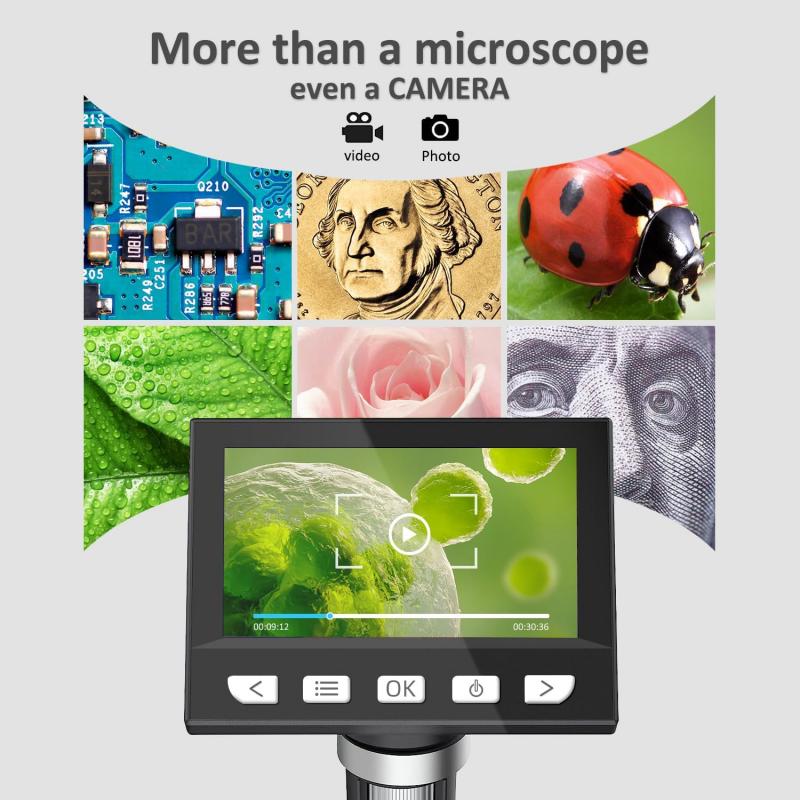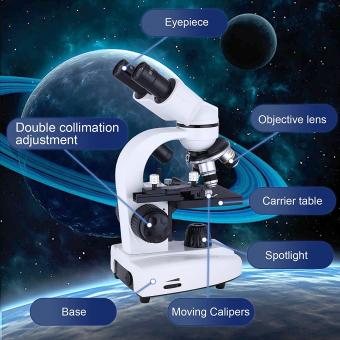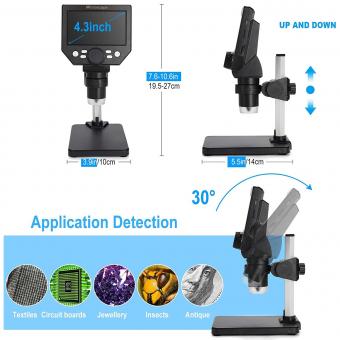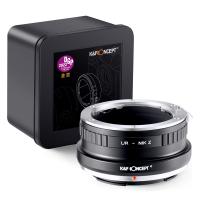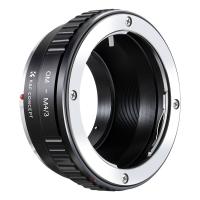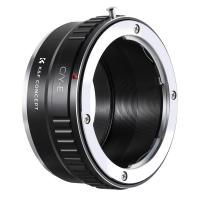What Microscope Can See Dna ?
A fluorescence microscope is commonly used to visualize DNA. This type of microscope utilizes fluorescent dyes that bind specifically to DNA molecules, allowing them to emit light when illuminated with a specific wavelength of light. This enables researchers to observe the location and distribution of DNA within cells or tissues. Additionally, electron microscopes, specifically transmission electron microscopes (TEM), can also be used to visualize DNA. TEM uses a beam of electrons to create an image of the sample, providing high-resolution details of the DNA structure. However, sample preparation for TEM is more complex and time-consuming compared to fluorescence microscopy.
1、 Fluorescence Microscopy: Visualizing DNA using fluorescent dyes.
Fluorescence microscopy is a powerful tool that can be used to visualize DNA using fluorescent dyes. This technique allows scientists to observe the structure and behavior of DNA molecules in a live or fixed sample.
Fluorescent dyes are molecules that absorb light at a specific wavelength and emit light at a longer wavelength. By labeling DNA with fluorescent dyes, researchers can specifically target and visualize DNA molecules within a sample. Different dyes can be used to label different parts of the DNA, such as the double helix or specific regions of interest.
One of the main advantages of fluorescence microscopy is its ability to provide high-resolution images of DNA. This allows scientists to study the fine details of DNA structure and organization. Additionally, fluorescence microscopy can be combined with other techniques, such as immunofluorescence or FISH (fluorescence in situ hybridization), to study the interaction of DNA with other molecules or to detect specific DNA sequences.
In recent years, advancements in fluorescence microscopy have further enhanced our ability to visualize DNA. Super-resolution microscopy techniques, such as stimulated emission depletion (STED) microscopy and single-molecule localization microscopy (SMLM), have pushed the limits of resolution beyond the diffraction limit. These techniques allow for the visualization of DNA at the nanoscale level, providing unprecedented detail.
Furthermore, the development of genetically encoded fluorescent proteins, such as green fluorescent protein (GFP), has revolutionized the field of fluorescence microscopy. These proteins can be fused to specific DNA-binding proteins, allowing for the direct visualization of DNA in living cells. This has opened up new avenues for studying DNA dynamics and interactions in real-time.
In conclusion, fluorescence microscopy is a valuable tool for visualizing DNA. It allows scientists to study the structure, organization, and behavior of DNA molecules in a variety of samples. With the latest advancements in super-resolution microscopy and genetically encoded fluorescent proteins, our ability to visualize DNA has reached new heights, providing valuable insights into the fundamental processes of life.

2、 Electron Microscopy: Revealing DNA structure at nanoscale resolution.
Electron Microscopy: Revealing DNA structure at nanoscale resolution.
Electron microscopy is a powerful tool that has revolutionized our understanding of the structure and function of biological molecules. When it comes to visualizing DNA, electron microscopy has played a crucial role in unraveling its intricate structure at the nanoscale level.
The most commonly used electron microscopy technique for studying DNA is transmission electron microscopy (TEM). In TEM, a beam of electrons is transmitted through a thin sample, and the resulting image is formed by the interaction of the electrons with the sample. This technique allows for the visualization of DNA at a resolution of a few nanometers, revealing the double helix structure and the arrangement of nucleotides along the DNA molecule.
In recent years, advancements in electron microscopy technology have further enhanced our ability to study DNA. Cryo-electron microscopy (cryo-EM) has emerged as a groundbreaking technique that allows for the imaging of biological samples in their native, hydrated state. This technique involves rapidly freezing the sample to preserve its structure and then imaging it using an electron microscope. Cryo-EM has provided unprecedented insights into the three-dimensional structure of DNA and its interactions with proteins and other molecules.
Furthermore, the development of advanced electron detectors and computational methods has significantly improved the resolution and image quality obtained from electron microscopy. This has enabled researchers to visualize DNA at an even higher level of detail, revealing finer structural features and dynamic processes.
In conclusion, electron microscopy, particularly transmission electron microscopy and cryo-electron microscopy, has been instrumental in revealing the structure of DNA at the nanoscale. With ongoing advancements in technology, electron microscopy continues to push the boundaries of our understanding of DNA and its role in various biological processes.

3、 Super-resolution Microscopy: Overcoming diffraction limits to visualize DNA.
Super-resolution microscopy is a powerful technique that has revolutionized our ability to visualize DNA at the nanoscale level. Traditional light microscopy is limited by the diffraction of light, which prevents the observation of structures smaller than approximately 200 nanometers. However, super-resolution microscopy techniques have overcome this diffraction limit, allowing for the visualization of DNA and other cellular structures with unprecedented detail.
One such technique is called stimulated emission depletion (STED) microscopy. STED microscopy uses a combination of laser beams to excite and deplete fluorescent molecules, resulting in a highly localized and precise imaging of DNA. This technique can achieve resolutions down to a few tens of nanometers, enabling the visualization of individual DNA molecules and their interactions within the cell.
Another super-resolution technique is called single-molecule localization microscopy (SMLM), which includes methods such as stochastic optical reconstruction microscopy (STORM) and photoactivated localization microscopy (PALM). These techniques rely on the precise localization of individual fluorescent molecules to reconstruct high-resolution images of DNA. By using specialized fluorophores and imaging algorithms, SMLM can achieve resolutions of a few nanometers, revealing the intricate structure and organization of DNA within the nucleus.
The latest advancements in super-resolution microscopy have further improved the resolution and capabilities of DNA imaging. Techniques such as DNA-PAINT (Point Accumulation for Imaging in Nanoscale Topography) and MINFLUX (Minimizing the Fluctuations of Molecular Emission) microscopy have pushed the boundaries of resolution even further, allowing for the visualization of DNA at the molecular level.
In conclusion, super-resolution microscopy techniques have revolutionized our ability to visualize DNA by overcoming the diffraction limits of traditional light microscopy. These techniques, such as STED microscopy, SMLM, DNA-PAINT, and MINFLUX microscopy, have enabled the visualization of DNA at resolutions ranging from tens of nanometers to the molecular level. This has provided valuable insights into the structure, organization, and dynamics of DNA within cells, advancing our understanding of fundamental biological processes.

4、 Atomic Force Microscopy: Examining DNA topography and mechanical properties.
Atomic Force Microscopy (AFM) is a powerful tool that can be used to visualize and study the topography and mechanical properties of DNA molecules. AFM is a type of scanning probe microscopy that uses a small probe to scan the surface of a sample and generate a high-resolution image.
AFM can provide detailed information about the structure and properties of DNA at the nanoscale level. It can reveal the three-dimensional shape of DNA molecules, including their twists, bends, and overall conformation. This is particularly useful for studying DNA-protein interactions, DNA folding, and DNA damage.
In addition to visualizing DNA topography, AFM can also measure the mechanical properties of DNA molecules. It can determine the elasticity, stiffness, and flexibility of DNA, which are important factors in understanding its biological functions. For example, AFM has been used to study the stretching and bending of DNA during processes such as DNA replication and transcription.
The latest advancements in AFM technology have further enhanced its capabilities for studying DNA. For instance, high-speed AFM allows for real-time imaging of dynamic processes, such as DNA-protein interactions or DNA strand separation. Additionally, AFM combined with fluorescence microscopy techniques enables the simultaneous visualization of DNA and specific proteins or molecules of interest.
Overall, AFM is a valuable tool for studying DNA at the nanoscale level. It provides detailed information about DNA topography and mechanical properties, allowing researchers to gain insights into the structure and function of DNA molecules. With ongoing advancements in AFM technology, its potential for DNA research continues to expand.
